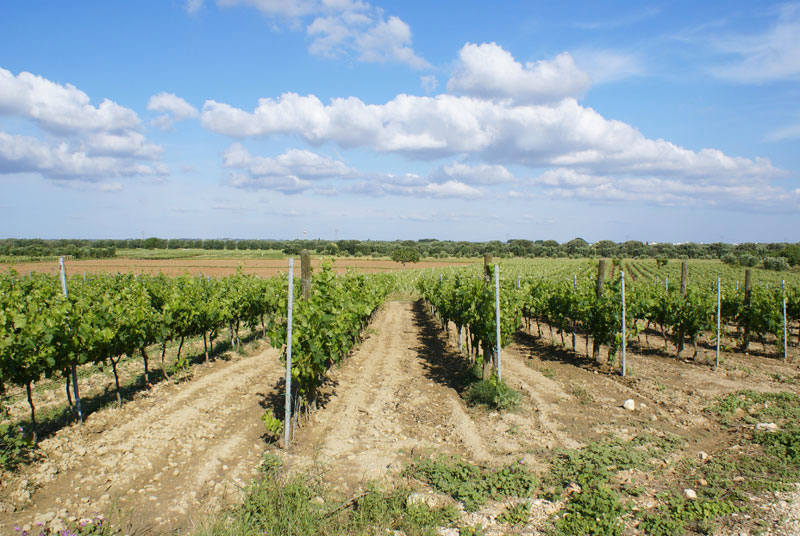
Among the wines of Puglia there is one that is less known than the others: the Susumaniello. This post was written by my cousin the sommelier Cosimo Ricciato.
In the last two-three years I was very pleased to find that Puglia, a region I know well also because I was born there (Salento) is also beginning to use pure autochthonous (1 – see at the end of this post) vines for the production of particularly interesting wines. A great job is being done on red grapes like the Negroamaro and the Primitivo, immediately after there are new rediscoveries like the Fiano Minutolo and the Verdeca, white grapes from the marvellous Valle d’Itria. Lately a vine with a particularly strange name is being heard of, the Susumaniello, an autochthonous red grape that is slowly catching up in pure vinifications as well.
History, diffusion and denomination
The Susumaniello is an autochthonous vine of Puglia, it can be defined as such thanks to the few and uncertain news that surround most of our autochthonous vines. An ancient vine with probable Dalmatian origins that don’t clarify how, when and why it arrived in Puglia precisely in the area of the high Brindisi area almost on the border with the first municipalities of the province of Bari. Its curious name is due to the fact that the vine, especially in the first 10-15 years of life, has the characteristic of being a very productive vine so much so that it fills up with an excessive amount of bunches of grapes, from here the very appropriate saying: “loaded like a donkey“. It is diffused all throught the Brindisi area and other wine producing areas around Ostuni and Fasano. New plants can be found in the High Salento area (Alto Salento) as proof of the trust that new wine makers have in the defense and regard of their territory also through the most historic autochthonous vines. The Susumaniello was mainly used in blend with other varieties of the area but lately it has been rediscovered also in some very interesting pure vinifications. It is included in the DOC disciplinary for the production of the following wines: Brindisi Doc, max 30% – Ostuni Doc Ottavianello max. 15%.
The Susumaniello plant
The Susumaniello is known also with the synonyms of Somarello nero (Black Donkey), Sumariello nero, Zuzomaniello, Cozzomaniello, Zingariello (from its Dalmatian origins), Grisamaniello and Lacrima Puglia (Tear of Puglia). The plant finds its right dimension when grown to a small tree, it presents itself with good vigour and has good tollerance to cryptogamic diseases. The bunch is of medium size with a medium size grape, the peel is a black-blue colour, pruinose, very thick and of medium consistency. Full ripening and grape harvest are usually done after the second decade of September. From the Susumaniello a red ruby intense wine is produced with slightly rustic notes where the fruity-vegetable prevails. They are wines with a good alcohol level that is well balanced by the tannic component that is slightly more incisive and “rustic” and by a good dose of acidity that makes it a wine perfect for medium ageing. Excellent accompaniment for tasty and full bodied first courses, grilled meats and medium matured cheeses like the typical pear shaped cheese, the Caciocavallo Podolico.
Susumariello “Serre”, I.G.T. Salento 2008, 13.5° of the Cantine Due Palme, Cellino San Marco (BR)

The wine looks clear, a very intense ruby red with purpleish refexes on the rim of the glass, consistent. The smell is intense with winey and fruity notes of pulpy red fruits like black cherry, prune and wild blackberry marmelade followed by vine leaf vegetables, spiced with green pepper and foxy accents, followed by slight notes of toasted vanilla that make the smell complex and fine. The taste is of a dry, warm and smoothe wine, the hardness is sapid and quite fresh, in this case the acidity leads the way for sapidity and the tannins are present but well tamed, not at all rough and impetuous, the six months passed in barriques served to unnerve them and make them a little less rustic (excellent choice). A full bodied wine with a good balance between hardness and softness, the alcohol in this case plays an important role and is also aided by the period of time, even if short, passed in the barriques. Intense and with a good persistency with a fruity comeback of black cherry and prune that make the olfactory-taste very fine. Quite a harmonic wine with a ready evolutionary state. Served at 16° it can accompany tasty first courses like lasagne, tagliatelle with ragù or second courses with grilled meats or medium matured cheeses like the Caciocavallo Podolico.
Suggested combination
Caciocavallo Podolico accompanied by Altamura Dop bread.
(1) “autochthonous” refers to grape varieties that are almost exclusively the result of natural cross-breeding or mutation in a particular growing area, and have a long history in that area. Throughout their development, they adjusted well to the local conditions – and today give their best quality under these same conditions.











